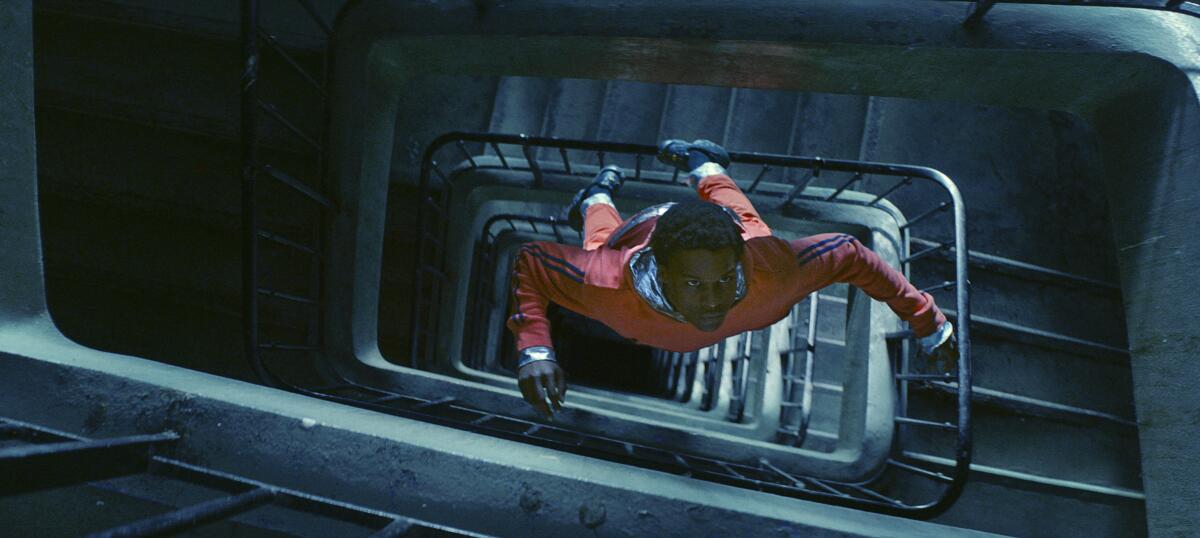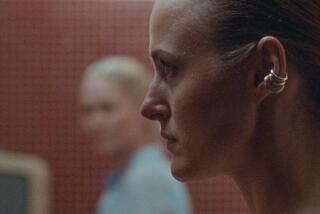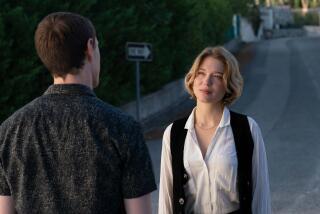Review: Fantastical ‘Gagarine’ transcends doomed setting with hope and heart

Any community on the brink of displacement would be lucky to have in its corner someone like Youri, the kind, attentive, and mechanically resourceful teenager at the center of the French film “Gagarine.” A sweet, melancholy magical realist drama from directors Fanny Liatard and Jérémy Trouilh, it’s set on the south fringes of Paris in a red-brick housing project where its young Black protagonist, played by newcomer Alseni Bathily, has lived his whole life.
If the names “Youri” and “Gagarine” sound historically familiar, it’s because the film was shot at a real location: Cité Gagarine, built by France’s then-powerful Communist Party and named for the Soviet cosmonaut Yuri Gagarin, who visited the modernist building in 1963 and was greeted with rose petals flung from residents’ windows. (Footage from that day opens “Gagarine.”)
For your safety
The Times is committed to reviewing theatrical film releases during the COVID-19 pandemic. Because moviegoing carries risks during this time, we remind readers to follow health and safety guidelines as outlined by the CDC and local health officials.
Over 50 years later, the T-shaped complex that once signified a bright future for its working class (and white) dwellers became a neglected, maligned symbol of a transformed France with an ethnically diverse population dealing with poverty and changing attitudes. But for the stargazing young man with the space pioneer’s name, a building in disrepair full of tight-knit but powerless residents isn’t a signal to give up — it’s an opportunity to fix, build, explore and entrench.
With a telescope trained on thriving pockets of his community, a notebook full of ideas and designs, and a burgeoning electrical know-how, Youri roams the grounds of Cité Gagarine with his friend Houssam (Jamil McCraven) to see where patches and improvements could be made to keep the only home he’s ever known from becoming another demolition project. (When he arranges a solar eclipse watching party for residents, it also acts as a bit of foreshadowing about approaching darkness.)
Trying to fix the elevator one day, he meets Diana (Lyna Khoudri), a Romany girl from the area whom he’s noticed working on cars. When she helps Youri procure new building lights from an industrial salvage guy (an expectedly crusty Denis Lavant), a friendship is born, one that lessens the sting from the gradual realization that his single mother has basically left him behind for a new life with a new lover. Bathily, an appealing presence, registers these shifts in warmth, optimism and hurt with remarkable subtlety for a first-time actor.
Despite his efforts, however, a new start is ultimately what the city has in mind, too. With Gagarine scheduled to come down, and relocation for the occupants in full swing, Youri makes squatting into a beautifully defiant extension of his science-and-technology mindset — turning his apartment and the vacated ones on the same floor into a pod-like starship, complete with functioning greenhouse, left-behind objects repurposed, and his own helmeted suit.
This is also when the filmmakers, with the aid of cinematographer Victor Seguin’s elegantly fluid shots and many fine sound/music craftspeople, begin to convey Youri’s ambition and isolation with elements of the fantastical, as if his near-metaphysical connection with a doomed place was the equivalent of a lone spaceman in countdown, hoping to achieve a kind a dreamlike liftoff from what will soon be a pile of debris from a previous architectural age. The first half’s sprightly, mostly daytime scenes of communal bustle in a real location — Liatard and Trouilh filmed onsite at the post-condemned Cité Gagarine before demolition began in 2019 — segues into a color-and-light-themed, theremin-scored, sci-fi fugue state.
Our awe at Youri’s Robinson Crusoe-like adaptive ingenuity is tempered by a concern for his earthly fate that makes the factual portion of the ending (that building’s coming down) a naturally tense climax, even as it fuses the storybook and the tangible. In its imaginative depiction of how marginalized souls view home — especially youth, for whom belonging and the future can be fraught concepts — “Gagarine” bears witness to not only a historic building, but the hearts of people, which is what brings a place alive, anyway.
'Gagarine'
In French with English subtitles
Not rated
Running time: 1 hour, 37 minutes
Playing: Starts April 1, Landmark Nuart, Laemmle Noho 7, Laemmle Town Center 5; Laemmle Claremont
More to Read
Only good movies
Get the Indie Focus newsletter, Mark Olsen's weekly guide to the world of cinema.
You may occasionally receive promotional content from the Los Angeles Times.










